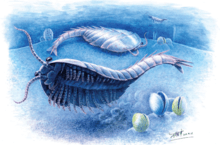Fuxianhuiida
Fuxianhuiida is an extinct clade of arthropods from the Cambrian of China. All currently known species are from Cambrian Series 2 aged deposits in Yunnan Province, including the Chenjiang biota. They are generally considered to be close to the base of Euarthropoda.[1] They reach a size of up to 15 cm, and are interpreted as benthic predators and scavengers.[2] The presence of gnathobases in members of Chengjiangocardidae suggests that they were capable of durophagy.[1]
| Fuxianhuiida | |
|---|---|
 | |
| Fuxianhuia | |
 | |
| Guangweicaris | |
| Scientific classification | |
| Kingdom: | Animalia |
| Phylum: | Arthropoda |
| Order: | †Fuxianhuiida Bousfield, 1995 |
| Genera | |
| |

The fuxianhuiid exoskeleton is unmineralised, and the number of tergites ranges from 15 to over 40. The cephalon is covered by a head shield and contains stalked eyes connected by the anterior sclerite, antennae, a butterfly shaped hyposome and a posterior facing mouth. Fuxianhuiids possess specialized post-antennal appendages with serrated edges used for food processing. In most fuxianhuiids, the thorax tergites narrow posteriorly, terminating in either a swimming paddle or paired flukes with a tailspine. In members of Fuxianhuiidae the thorax is divided into two sections, the anterior wide opisthothorax and the posterior narrow limbless tail-like abdomen.[2] Many specimens are known with exceptional soft tissue preservation, including preserved guts and neural tissue, which given their basal phylogenetic position makes them important in understanding the evolution of arthropoda as a whole.[3]
Taxonomy
Per[1]
| ||||||||||||||||||||||||||||||||||||||||
It was subsequently suggested that Shankouia zhenghei was synonymous with Liangwangshania biloba, with sexual dimorphism accounting for variation between specimens.[4]
References
- Yang, Jie; Ortega-Hernández, Javier; Legg, David A.; Lan, Tian; Hou, Jin-bo; Zhang, Xi-guang (2018-02-01). "Early Cambrian fuxianhuiids from China reveal origin of the gnathobasic protopodite in euarthropods". Nature Communications. 9 (1): 470. Bibcode:2018NatCo...9..470Y. doi:10.1038/s41467-017-02754-z. ISSN 2041-1723.
- Ortega-Hernández, Javier; Yang, Jie; Zhang, Xi-guang (2018-07-01). "Fuxianhuiids". Current Biology. 28 (13): R724–R725. doi:10.1016/j.cub.2018.04.042. PMID 29990450.
- Yang, Jie; Ortega-Hernández, Javier; Butterfield, Nicholas J.; Liu, Yu; Boyan, George S.; Hou, Jin-bo; Lan, Tian; Zhang, Xi-guang (2016-03-15). "Fuxianhuiid ventral nerve cord and early nervous system evolution in Panarthropoda". Proceedings of the National Academy of Sciences. 113 (11): 2988–2993. Bibcode:2016PNAS..113.2988Y. doi:10.1073/pnas.1522434113. ISSN 0027-8424. PMC 4801254. PMID 26933218.
- Chen, Ailin; Chen, Hong; Legg, David A.; Liu, Yu; Hou, Xian-guang (September 2018). "A redescription of Liangwangshania biloba Chen, 2005, from the Chengjiang biota (Cambrian, China), with a discussion of possible sexual dimorphism in fuxianhuiid arthropods". Arthropod Structure & Development. 47 (5): 552–561. doi:10.1016/j.asd.2018.08.001. PMID 30125735.